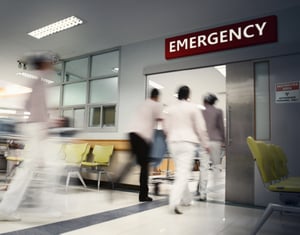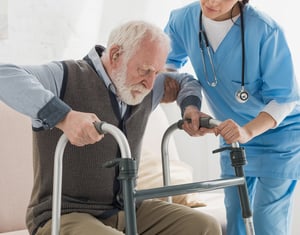
Risk Management Bundles
Risk Management Bundles collect our most useful Risk Management resources on a topic into an easy-to-navigate collection.
Table of Contents







Disaster Mitigation
The lack of predictability and the potential long-term effects of a natural disaster can cripple an unprepared healthcare entity. The four phases of emergency management―mitigation, preparedness, response, and recovery―can be used as a framework to decrease vulnerabilities, improve response, and speed return to normal operations after a natural disaster.
Below you’ll find strategies and resources for improving patient safety and reducing liability risk in the event of a natural disaster, which can be integrated into a general emergency preparedness and management plan.
Natural disaster mitigation strategies are unique in that they focus on reducing the severity of the impact, instead of preventing the hazard. A risk assessment should provide the basis for mitigation strategies to improve readiness, response, and recovery.
- Identify mitigation activities required by law, accreditation by professional organizations (e.g., Joint Commission Emergency Management Elements of Performance), and participation in government programs (e.g., Centers for Medicare and Medicaid services (CMS) Emergency preparedness rule).
- Based on the risk assessment, prioritize facility-specific mitigation measures, such as redundancy of power, communications, and data management systems (e.g., obtaining uninterruptible power supplies (UPS) and emergency standby generators for critical equipment); installing water-tight subbasement doors; reinforcing tornado/earthquake safe rooms; installing window film to prevent injuries from shattered glass; etc.
- FEMA has various Hazard Mitigation Assistance grant programs, including benefits for hospital power generators.
- Review insurance policies to determine whether they adequately cover potential losses.
Preparedness involves a continuous process of planning, training, testing, evaluating, and correcting to ensure the best disaster response and recovery possible. The cycle of preparedness begins with risk assessment and results in a plan. The plan should include training that helps ensure everyone knows their roles and responsibilities and can perform their designated duties in response to a disaster. Due to the nature of natural disasters, preparedness and mitigation strategies may overlap.
- Conduct a risk assessment (also referred to as a hazard vulnerability analysis (HVA)) to identify potential geographic vulnerabilities in practice locations. For example, geographic vulnerabilities include hurricanes in coastal areas, earthquakes on the west coast, and blizzards and ice storms in increasingly expanding areas across the United States.
- Prepare for each vulnerability identified in the risk assessment. For example, have plans, agreements, protocols, and policies in place for:
- Patient evacuation to another facility to continue care in the event of facility destruction, patient transfer to an alternate care facility or sheltering in place.
- Increased staffing immediately after a natural disaster, for example, granting temporary privileges to clinicians.
- Alternative means of meeting essential building utility needs, for example, maintaining healthcare operations during power outages, including protecting refrigerated vaccines and maintaining water supply.
- Create a crisis management team and designate a command center.
- Develop an effective emergency response plan, which may include an Emergency Operations Plan (EOP) and a Continuity of Operations Plan (COOP), for Joint Commission accredited organizations.
- Review and update plans on a regular basis.
- Develop a business continuity plan.
- Develop and implement disaster preparedness training programs.
- Plan, test, and simulate the most likely disaster scenarios that may occur.
- Review the results of simulations and facility response to identify opportunities for improvement.
- Develop a plan for communication with stakeholders.
- Maintain a contact list for the supplies; services; and community, state, and federal resources that will be necessary during response and recovery from a disaster.
- Include processes for patient identification and family notification in an emergency.
- Appoint and train a spokesperson and backup spokesperson.
- Be prepared to use social media.
Additional Mitigation and Preparedness Resources and Toolkits
Emergency Preparedness Rule – CMS Emergency Preparedness Rule
Preparedness Planning for Your Business – Ready.gov - Emergency Response Plan
About the Hospital Preparedness Program – HHS – Public Health Emergency
ASPR’s Hospital Preparedness Program (HPP) – Guidance and technical assistance to help healthcare coalitions and their members.
Hospital Preparedness Checklists and Tools – California Hospital Association
Hospital tools and resources for disaster planning, including checklists for the development of an Incident Action Plan, water disruption best practices, hospital evacuation, and repopulation.
Hospital Disaster Preparedness for Obstetricians and Facilities Providing Maternity Care – ACOG
Preparing for a Volcanic Eruption - CDC
Emergency Preparedness - AHCA/NCAL
Response is the third phase of managing an emergency and includes those activities immediately before an impeding threat, during, and after a disaster impact and addresses the immediate and short-term effects. It usually focuses on providing emergency medical treatment to those affected, minimizing secondary impacts, and limiting the negative effects of the situation.
A responsive organization maintains an organized structure under emergency conditions. It also conducts information management, emergency decision-making, incident planning, actions to implement decisions, and coordination of resources.
Consider activating a systems-based response with the following in mind.
- Protect personnel, current patients, visitors
- Provide the best available medical care for responders, victims/patients, and affected families
- Protect critical infrastructure, facilities, vital records, and other data
- Manage regulatory compliance
- Restore essential services
Communication
An effective incident command structure triggers notification to key personnel and the incident management team. The Federal Emergency Management Agency (FEMA) has education and training on incident command structures available at https://training.fema.gov/nims/.
The National Institute for Occupational Safety and Health (NIOSH) has created a document communicating key messages associated to the multiple hazards related to storms, floods and hurricanes.
Patient Care
Typical patient care concerns following a disaster include follow-up, transfers, and medication management.
- As you are able, review schedules to determine which patients have acute issues and upcoming or missed appointments in the outpatient hospital departments and the on campus medical office building. Attempt to contact patients, prioritizing by urgency.
- Document all ongoing communication and resulting action and status.
- Document where you instructed patients to go (e.g., shelter, clinic, urgent care, emergency department), or if other arrangements were made (e.g., home health visit, telehealth visit).
Medication Management
Patients may need replacement prescriptions for medications or they may be due for refills. You may also encounter displaced patients who are seeking care in your community.
- Handle the prescription management process carefully and in compliance with law and regulation. The State Board of Pharmacy for individual states can be a reliable resource in a state of emergency.
Documentation Accompanying Hand-Offs/Transfers
If your facility is required to evacuate patients, tracking those patients is a key risk management measure. Documentation to accompany patients should ideally include critical information to support continuity of care and treatment, such as:
- Patient name and date of birth
- Allergies
- Medications
- Problem list
- Emergency contact
- Copy of Medication Administration Record (MAR)
- Copy of most recent discharge or care summary
- Copies of latest lab reports
- Primary care physician information
Source: https://www.health.state.mn.us/communities/ep/surge/sheltering/index.html
Medical Record Documentation During Evacuation or Hand-Off
Considerations for medical record documentation during evacuation or hand-off may include the following.
- Evacuation/triage level
- Patient condition
- Availability of medical record
- Disposition (e.g., home, shelter, transfer)
- Accepting location and physician
- Arrival confirmation
- Medications, personal belongings, equipment accompanying patient
- Times (departure, arrival)
- Family notification
- Communication with local, regional, and federal authorities
Security and Privacy of Medical Information during Response
While the HIPAA Privacy Rule is not suspended during a public health or other emergency, if the Secretary of HHS declares a public health emergency in your state, then HHS may exercise its authority to waive sanctions and penalties associated with HIPAA violations.
Social Media Response
- Consider having a designated person update social media to keep the public notified as circumstances change.
- Disseminating accurate, timely, and appropriate updates can help calm both patients and family members as well as reduce overall panic.
- Proper monitoring of social media and response information may dispel rumors and the spread of misinformation.
Power Failures and Staffing Shortages
- Without electricity, healthcare organizations may need to use a numbering system to track patients, their diagnoses, and treatment.
- Healthcare organizations may need increased staffing immediately after a natural disaster because some staff may be unable to continue working. Organizations may have to grant temporary privileges to providers during a disaster. Natural disasters can also have a larger impact on your organization’s staff since they may also have lost personal property, homes, or loved ones.
- The Department of Homeland Security provides general guidelines and tips for preparing for and responding to a power outage.
Accreditation Bodies and Payor Resources
Core EP Rule Elements Resources - Centers for Medicare and Medicaid Services.
Emergency Management Resources - The Joint Commission.
The last phase—recovery—is the resumption of normal operations and services, begins simultaneously with response actions, and includes those activities to assess—including the need to notify the appropriate insurance carriers—manage, and facilitate recovery.
Many healthcare entities may suffer water and wind damage during a natural disaster; some may have standing water for an extended period due to flooding. Building structures, equipment, and supplies may be heavily contaminated with microorganisms such as mold, mold spores, and bacteria.
Before reopening, healthcare entities must be evaluated to determine if the facility is damaged beyond repair and must be condemned or if the extent of the damage is such that the facility may be restored, repaired, and reopened.
Disaster Site Management
- A full debriefing is needed to detail what supplies have been depleted, staff issues, mutual agreements honored, supply management issues, and what repairs are necessary to continue business operations. For example, if the area of the organization’s pharmacy is flooded, mold and cleaning remediation will be necessary to make the structure useable. Pharmacy inventory will need to be replaced.
- Resources and information for infection control considerations for reopening healthcare facilities due to extensive water and wind damage may be located on the CDC website.
- The National Institute for Occupational Safety and Health (NIOSH) provides guidance on the management of chemical structural hazards, asbestos, carbon monoxide, heat stress, confined spaces and electrocution.
Damaged or Destroyed Medical Records
Many healthcare facilities and physician offices will be trying to recover and restore damaged paper and electronic records in the weeks and months following the wildfires. Before investigating potential damage to paper medical records:
- Ensure the storage location is safe to enter.
- Call your general liability/property insurer for directions and recommendations.
- Execute business associate agreements with any vendor hired to help recover PHI.
Best Practice Considerations for Handling Water Damaged Records
- Handle them as little as possible and keep them from molding.
- Mold starts to grow quickly—within two to three days—so it is important to act as soon as possible.
- Reduce the temperature and humidity and increase the circulation in the record storage area.
- If a professional document drying company cannot be contacted within 48 hours, place the records in a freezer.
- Do not open or clean the records.
- Pack records tightly to avoid movement during transport.
- Do not thaw the records without obtaining professional advice.
Document Drying/Restoration Resources
National Resource Guide for Disaster Preparedness (PDF) - Conservation Center
Emergency Salvage of Flood Damaged Documents
Emergency Salvage of Wet Books and Records
Mold Resources
After the Flood: Mold Specific Resources – ASPR TRACIE
Preventing Occupational Respiratory Disease from Exposures Caused by Dampness in Office Buildings, Schools, and Other Nonindustrial Building – NIOSH
Reconstructing the Medical Record
State Medical Boards require a physician to maintain adequate and accurate records. Failure to do so may represent unprofessional conduct. If you cannot salvage medical records or otherwise reconstruct them via electronic data recovery, you should recreate them to the best of your ability.
Approach the various other entities that are storing your patients’ PHI in their own databases and record-keeping systems. For example, pharmacies, consultants, prior treating physicians, third-party insurers, transcription services, and hospitals most likely have PHI they can provide. The following strategies can facilitate the reconstruction process:
- Inform patients in writing of their PHI destruction.
- Include the date and circumstances.
- Describe attempts to reconstruct their records.
- Send the patient a history form.
- Invite the patient to contact you to provide additional information.
- Keep a copy of the patient record in the patient’s new file.
- Date the reconstructed record with the current date.
- Identify the record as reconstructed PHI so there is no question as to whether the record is reconstructed or original.
- Contact third party insurers as soon as possible to determine whether they require attestation forms.
Documentation of Medical Record Destruction/Recovery/Reconstruction Efforts
- Describe the event (date, severity, duration, etc.).
- Describe the loss of PHI.
- Construct a log of damaged or destroyed records.
- Include photograph/video records of the damage and copies of property insurance claims documentation.
- Describe efforts to reconstruct PHI.
- Enter a description of the event and reconstruction efforts into reconstructed patient record.
- If affected PHI is requested, include documentation of PHI damage and recovery efforts with your response to the PHI request.
The CDC has a number of specific resources on how to prepare for and manage dangerous natural events, including extreme hot and cold temperatures, hurricanes, wildfires, and earthquakes.
Hurricanes
Hurricanes and their impacts present significant challenges to physicians and healthcare entities in the affected areas. As hurricanes make landfall, they often bring heavy rain and strong winds to the affected areas and surrounding regions.
We’ve collected references and strategies for preparing for the possibility of hurricane and flood-related issues that physicians, dentists, and healthcare entities are expected to encounter.
Hurricane and Flood Resources
Hurricane Risk Mitigation and Preparedness Checklist – ProAssurance
Tips about Medical Devices and Hurricane Disasters – FDA
Practice Preparation Checklist for Hurricane Season - DAS Health
Active Hurricanes, Cyclones, and Disturbances – National Hurricane Center and Central Pacific Hurricane Center
Flood Preparedness and Response – OSHA
DHS
DHS Ready Check Hurricane Readiness Checklist
Ready Business Hurricane Toolkit (PDF)
Ready Business Inland Flooding Toolkit (PDF)
HHS TRACIE
Hurricanes
Hurricane Resources at Your Fingertips (PDF)
HHS
Public Health Emergency Resource for Professionals
US Department of Labor OSHA Hurricane Preparedness and Response
CDC Post-Hurricane Safety Advice for Healthcare Professionals
Wildfires
Wildfires can have a devastating impact on physicians and healthcare organizations as they strive to deliver safe patient care. Administrators and providers also need to be concerned about having complete medical records and ensuring that access to records is handled appropriately and protects patient confidentiality.
Depending on the circumstances and your current resources and capabilities, you may be unable to accomplish activities as you would during normal daily operations. The main objective is to provide safe and appropriate care to your patients.
Wildfire Resources
Wildfires - The Centers for Disease Control and Prevention (CDC)
U.S. Department of Health and Human Services (HHS), Assistant Secretary for Preparedness and Response (ASPR), Technical Resources, Assistance Center, and Information Exchange (TRACIE). EXCHANGE Newsletter, Issue 10, 2020, Lessons learned from recent wildfires, including evacuating and receiving patients, and preparing for power outages.
Earthquakes
Although California is the state most likely associated with earthquakes, other states including Alaska, Oregon, and Washington are also at increased risk. In addition to potential injuries and business interruption associated with structural failure, earthquakes can cause fires, tsunamis, landslides, and avalanches. Therefore, many of the mitigation, preparedness, response, and recovery strategies associated with other natural disasters can also be applied to earthquake plans.
Earthquake Resources
Earthquake Preparedness for Community Clinics and Health Centers – California Primary Care Association and National Association of Community Health Centers
Earthquake Drills for Healthcare Organizations – Great ShakeOut
Volcanoes
Preparing for a Volcanic Eruption - CDC
Emergency Preparedness - AHCA/NCAL
Obstetrics Resources
Postpartum depression (PPD) is a serious mental illness that can affect women after they give birth. It can cause a variety of symptoms, including sadness, anxiety, fatigue, and difficulty bonding with the baby. PPD can have a negative impact on the mother's health, the baby's health, and the family's overall well-being.
- The American College of Obstetricians and Gynecologists’ Committee opinion on perinatal depression can be found here.
- A standardized, validated tool such as the Edinburgh Postnatal Depression Scale (EPDS) can be found here.
- For more information and resources on postpartum depression, visit Postpartum Support International (PSI).
A birth plan should be a clear and concise document that outlines the individual's preferences for their birth experience, while remaining flexible to the unpredictable nature of labor and delivery. It is important to discuss the birth plan with each patient before labor and delivery to ensure the plan is understood and feasible within the context of the individual's medical situation.
Considerations when developing a birth plan:
- Labor and delivery preferences: This includes things like location of delivery (hospital, birthing center, home birth), preferred delivery method (vaginal birth or cesarean section), and pain management options (such as epidural or natural pain management techniques).
- Neonatal care preferences: This includes things like feeding preferences (breastfeeding or formula feeding), delayed cord clamping, skin-to-skin contact after birth, and circumcision preference.
- Special requests: This includes any special requests that the individual has, such as music preferences, photography or videography during labor and delivery, or religious or cultural traditions that should be observed.
- Medical concerns: This includes any allergies or medical conditions that may affect labor and delivery, medications that should be avoided during labor and delivery, and special medical interventions that may be necessary.
The American College of Obstetricians and Gynecologists (ACOG) supports vaginal birth after cesarean (VBAC) for most women with a prior cesarean delivery. ACOG recognizes that VBAC can be a safe and appropriate option for most women who have had a prior cesarean delivery, including those with two previous low transverse cesarean incisions.
- Hospitals and birthing centers offering VBAC should have emergency cesarean delivery resources
- Obstetric care providers should be skilled in vaginal birth, cesarean delivery, and management of complications
- Women considering VBAC should receive counseling on risks and benefits
- Decisions regarding mode of delivery should be individualized
In summary, ACOG supports VBAC as a safe and appropriate option for most women with a prior cesarean delivery, provided that appropriate resources and skilled care providers are available, and that women are fully informed of the risks and benefits of VBAC. Ultimately, the decision to attempt VBAC should be individualized and based on the woman's medical history, obstetric risk factors, and personal preferences.
- Doulas are trained to provide emotional and physical support to women during labor and delivery.
- Doulas do not offer medical care but are there for the emotional support of the mother. If hospitals utilize doulas, there should be written guidelines regarding the role.
The American College of Obstetricians and Gynecologists (ACOG) recognizes midwives as important members of the maternity care team and supports collaborative practice between midwives and obstetricians. However, like any medical intervention, there are potential risks associated with the use of midwives. Some of these risks include:
- Midwives’ scope of practice comparatively limited to that of obstetricians, as they are not educated, trained, or equipped to handle certain complications that can arise during pregnancy and childbirth.
- Limited access to medical interventions: Midwives may not have access to medical interventions such as epidurals or cesarean sections, which may be necessary in certain situations.
- Delay in emergency care: Midwives may not be able to provide immediate emergency care in the event of a complication, which could result in serious harm to the mother or baby.
- Inappropriate patient selection: In some cases, midwives may not appropriately identify high-risk pregnancies or may encourage women to deliver at home when a hospital birth may be safer.
- Lack of coordination with obstetricians: Collaboration between midwives and obstetricians is important for ensuring the best possible outcomes for mother and baby. If midwives and obstetricians are not working together, important information may be missed or overlooked.
- It is important to note that these risks are not unique to midwives and can also occur in any type of childbirth setting. The decision to use a midwife or obstetrician should be made based on the individual needs and preferences of the mother, as well as the medical circumstances surrounding the pregnancy and delivery.
- Midwives Alliance of North America (MANA)
- Resources and information about the midwifery laws in each U.S. state or territory
- Termination of care for a pregnant patient should be given special consideration.
- During the first trimester, termination should occur only if the pregnancy is uncomplicated, and the patient has sufficient time to find a new practitioner.
- In the second trimester, termination is permissible for uncomplicated pregnancies only, provided the patient has already transitioned to another practitioner before the cessation of services.
- In the third trimester, termination should generally be avoided and should occur under exceptional circumstances only.
- The American College of Obstetricians and Gynecologists (ACOG) has published guidelines for obstetricians who are considering terminating a pregnant patient from their care.
- ACOG emphasizes the importance of maintaining continuity of care, patient autonomy, and ethical considerations.
- Termination of care may be considered under certain circumstances, such as repeated missed appointments, non-compliance with recommended care, threatening or violent behavior toward healthcare providers or staff, and inappropriate or unreasonable demands or requests.
- Every effort should be made to address the issues with the patient and work collaboratively to resolve them before terminating care.
- In cases where termination of care is deemed necessary, ACOG recommends providing the patient with a written notice of termination, offering to transfer care to another provider, ensuring adequate time to find a new provider, and addressing the patient's medical needs until they establish care with a new provider.
Overall, ACOG emphasizes the importance of maintaining patient autonomy and ensuring the patient's medical needs are met, while also recognizing the need for obstetricians to protect themselves and their staff from abusive or threatening behavior.
State laws on patient abandonment vary, and some states’ laws are more specific than others.
Contact a ProAssurance Risk Management Consultant (844-223-9648 or RiskAdvisor@ProAssurance.com) for guidance on properly ending a physician-patient relationship.
We are committed to keeping you informed and protecting your practice of medicine as it relates to the professional liability implications of the U.S. Supreme Court’s ruling on Dobbs v. Jackson Women's Health Organization, which overturned Roe v. Wade and Planned Parenthood v. Casey.
- The American College of Obstetricians and Gynecologists (ACOG) recommends the use of chaperones during certain gynecologic exams and procedures.
- A chaperone may be used if the patient requests one or if the physician feels it is necessary.
- ACOG does not provide specific guidance regarding the qualifications or training required for a chaperone, but they do suggest that the chaperone be a trained healthcare professional, such as a nurse or medical assistant.
- The chaperone should also be of the same gender as the patient unless the patient requests otherwise.
- The purpose of a chaperone is to provide emotional support to the patient and to prevent any potential misunderstandings or inappropriate behavior during the exam or procedure.
- The chaperone should not interfere with the physician's ability to perform the exam or procedure and should maintain confidentiality and professionalism at all times.
Overall, while ACOG recommends the use of chaperones in certain situations, the decision to use one ultimately depends on the patient's preferences and the physician's clinical judgment.
Contact our Claims Intake Hotline if an adverse event occurs that you think could become a claim. Our claims specialists can then assist you in disclosure and communication with the patient and family. Call our Claims Intake Hotline toll-free at 877-778-2524 or email ReportClaim@ProAssurance.com.
- Ensure open, sincere, and effective communication with the patient and their family, if an adverse event or unanticipated outcome occurs in your practice.
- Doing so may mitigate the risk of a potential claim or lawsuit and may be necessary due to mandatory state disclosure laws.
General guidelines for communicating with the patient or family after an adverse event:
- Plan what you intend to say and review your plan with a ProAssurance Claims Specialist, if possible.
- Consider having a fact witness present during the discussion, perhaps your nurse or one of your partners.
- Spend plenty of time with the patient and family members. Listen to their questions and answer them to the best of your ability.
- Focus on the patient, not on yourself.
- Sincerely acknowledge the patient’s and/or family’s suffering. Do not belittle a complication. Do not point fingers or blame other physicians or staff members.
- Apologizing for the fact that the incident occurred may be appropriate. Example: “I’m sorry this has happened to you, and I want to assure you I’ll continue to oversee your care.”
- Do not overwhelm the patient and family with information. In complicated cases, it is best to schedule multiple conversations so they can better digest the information.
- Discuss the patient’s current condition and continued treatment, as well as the event’s definitive medical consequences on the patient’s health (if known).
- Do not speculate. If you do not know what happened, admit this. Then tell the patient and family you are investigating the situation and will let them know as soon as you have answers.
- Assume all conversations with patients are being recorded and conduct conversations accordingly.
- Provide the patient and family with your contact information.
Document the discussions, including:
- The date, time, and location of the discussion.
- The parties and relationships of those present.
- Your commitment to share additional information as it becomes available and to assist the patient and family.
Do not make any admissions of liability or statements of blame. Do not make any references to the cause of the outcome or any future peer review proceedings.
For more information, see Two Minutes: What’s the Risk? Unexpected Outcomes.
Our goal is to help save you time by providing resources and a variety of templates your practice can edit to fit your specific needs, as you deem appropriate. Since laws vary from state to state, please contact ProAssurance Risk Management to discuss specific situations or if you would like us to review your practice's template modifications.
Forms, Policies & Procedures
- Chaperone Guideline
- C-Section Hospital Documentation Template
- Cyber Liability Checklist
- Diagnostic Test and Referral Tracking Form
- Edinburgh Postnatal Depression Scale
- Ob Risk Assessment Checklist
- Patient Satisfaction Survey
- Patient Satisfaction Survey Policy
- Postnatal Depression Screening Guideline
- Shoulder Dystocia Hospital Documentation Template
- Withdrawal from Care or Terminating the Ob Physician-Patient Relationship Guideline
- Withdrawal from Care or Terminating the Ob Physician-Patient Relationship Letter
Skills Checklists
Informed Consent Forms
Senior Care Facilities Resources
Falls
- Each facility should have a fall management program in place. Fall management programs can be found at the Agency for Healthcare and Quality (AHRQ) and U.S. Department of Veterans Affairs (VA) websites, among others.
- The facility’s protocols, policies, and procedures should include a post fall huddle (PFH) review. Consider developing a PFH template.
- PFHs are confidential and are not included in the medical record; they provide a template to examine any unanticipated event.
- A case scenario, along with an outline of components of a PFH, have been prepared to augment staff education.
- The Joint Commission recommends the PFH as a strategy to review fall and injury risk factors with the ultimate goal of prevention.
Suggested Post Fall Huddle Components
- The first action is to determine if emergency care is needed and to act accordingly.
- The team should convene within 15 minutes of the fall event, or in accordance with facility policy.
- The staff member in charge of the resident, designated Post Fall Huddle Team Leader (TL), makes an announcement of an immediate huddle.
- Involve the resident whenever possible.
- Require individuals to gather and use “Group Think” (consensus of a group rather than a decision by an individual) to discover what happened.
- Involve interdisciplinary team members whenever possible (such as RN, NP, MD, PT, members of nursing staff (LPN, CNA), who know the resident (no more than 3-4 people to not overwhelm the resident).
- The TL completes the PFH form.
- The appropriate clinician:
- Modifies the resident’s plan of care to include identified interventions.
- Communicates new interventions during resident hand-off reports.
- Documents the fall event in the EMR per facility policy and guidelines.
- After the post fall huddle, the Nurse Manager should follow-up with staff and the resident to ensure interventions are implemented, and the resident understands the interventions.
- The Nurse Manager should be available to answer any questions or concerns voiced by resident or family.
Post Fall Huddle Scenario
A resident was admitted on day shift to the rehabilitation-nursing unit for post-operative hip replacement care. During the night shift, around 8:30 p.m., the nursing staff heard a loud noise in the resident’s room. When the CNA entered the room, she found the resident on the floor with her foot tangled in the bed sheet near an overturned walker. The CNA then called for assistance. The resident said she was not hurt, and the walker was too far away from the bed. As the resident was reaching for the walker, she lost her balance and fell. Her vital signs were within normal limits, including blood glucose. She denied any dizziness when she attempted to stand.
The RN arrived and quickly assessed the resident. Together, they assisted the resident to the bed using a lift, placed the call light within reach and re-educated the resident on the use of the call light for assistance.
The RN called team members for a Post Fall Huddle.
Communication
Effective communication is integral to quality healthcare. You may have excellent clinical skills and a state-of-the-art facility; however, if communication is not a priority, you may increase your liability exposure. Consider incorporating the following guidelines to further enhance patient safety:
Communication Skills Checklist
Limited English Proficiency Residents
We suggest first determining the need for language services. To help determine your obligation to provide meaningful access, consult HHS.gov for guidelines and answers to frequently asked questions.
The numerous options available may include, but are not limited to:
- Employing bilingual staff
- Enlisting community volunteers to interpret
- Using telephone or video conferencing interpretation services
- Hiring or contracting with qualified on-site interpreters
- Using written transcription and translation services
- Sharing the costs of resources or services with other facilities
The facility may also allow the patient to use family or friends to translate; however, the resident’s potential reluctance to disclose sensitive medical information in the relative’s/friend’s presence should be considered. In addition, the relative or friend may not convey the message objectively and effectively. In many cases, the family member may be a minor child who does not yet have the education or maturity to convey critical information.
The communication method(s) chosen should be accurate, effectively convey medical terminology, and maintain confidentiality.
Document in the medical record the communication method(s) agreed upon by resident and provider, or resident’s refusal of translator services.
- Emergency Preparedness - AHCA/NCAL
Workplace Violence in Healthcare
Widespread violence against physicians and other healthcare professionals continues to rise. Workers in healthcare settings have significant exposures to violence that can result in fatal & life-changing injuries. Exposure can come from patients or residents, family members, facility visitors, and from healthcare workers. These serious events can result in significant physical injuries, temporary or permanent disability, psychological trauma or even death. Workplace violence situations also have a negative impact on organizational culture as they adversely impact worker morale and increase work stress and staff turnover. There are a variety of direct and indirect risk factors impacting the healthcare industry. It is important to evaluate all aspects of the workplace violence program systematically. Regular review is necessary to identify deficiencies and opportunities for improvement. The core elements are interrelated, and each is necessary to the success of the overall system.
Workplace violence in the healthcare setting is not a new problem, however it is a growing issue of concern. The Joint Commission has issued Sentinel Alerts from as far back as 2008. According to the US Bureau of Labor Statistics, health care and social service workers were five times more likely to experience workplace violence than all other workers, comprising 73 percent of all nonfatal workplace injuries and illnesses requiring days away from work.
Preparation is key in mitigating risk. Many healthcare advocacy organizations have been proactive in assisting with educational efforts on how to build safe measures involving workplace violence. The American Society for Health Care Risk Management’s “Workplace Violence Toolkit” is a great example of such efforts.
Developing a clear plan to identify, report and respond to threats and violent incidents is an essential step in the preparation process.
- Workplace violence plans should include procedures to identify and evaluate risk factors for workplace violence, correct hazards, prepare for workplace violence emergencies, and respond to and investigate violent incidents. Additional information on developing workplace violence plans can be obtained from OSHA.
- Consider implementing a Patient Behavioral Agreement upon initial intake and annually thereafter. The agreement defines expectations and consequences of non-compliance. While certain patient behaviors may warrant immediate termination (violence, threats, destruction of property), other actions may be correctible, thus preserving the physician-patient relationship. The sample form Notice of Inappropriate Behavior may assist you in rehabilitating patients who engage in inappropriate behavior, but their actions do not warrant immediate termination. *If an incident report is completed, do not file the incident report in the medical record.
- Ensuring dangerous activities never get started at all is the best way to prevent them from escalating to someone being harmed. Physical security measures are often simple and cost-effective methods for minimizing and preventing potential workplace threats. Installing door locks, door jammers, bulletproof transaction windows, blind corner mirrors and “panic” alarms are several relatively straightforward security-enhancing options. More sophisticated systems that incorporate biometric security sensors and camera systems may be the best option for large practice settings and hospitals.
- The American Academy of Family Physicians (AAFP) has developed a comprehensive Preventing Violence in Health Care Toolkit that touches on issues such as intimate partner violence, bullying, and gun violence prevention.
- View the Violence in the Office Practice Setting: Preparation and Response seminar by signing into the secure services portal.
After a plan has been developed, the next step is to properly deploy it. This can be accomplished through routine staff training, instruction
- For new employees, training should begin during the onboarding process. All staff members should receive training on an annual basis, and more frequent sessions may be necessary for high-risk settings. Visiting providers and contract professionals should receive the same training as regular employees. Diligent training efforts allow staff members to develop skills and practice procedures that keep both them and patients safe during a workplace violence event.
- Another tool to consider in your education and training regimen is mock drills. Mock drills help simulate the stress and confusion of an actual workplace violence event and afford staff the opportunity to gain confidence in applying workplace violence strategies. Contact local law enforcement about their availability to assist you in developing mock drill training programs.
- View the January 2022 Claims Rx article Workplace Bullying.
- Staff Education: view Disruptive Patient Behavior video.
Organizational response and evaluation are critical elements of an effective violence prevention plan. An effective policy outlines the immediate steps leading to the provision of first aid and emergency services to injured workers, patients, visitors, and families.
- Organizational policies should encourage the reporting of workplace violence. OSHA defines workplace violence as any act or threat of physical violence, harassment, intimidation, or other threatening disruptive behavior that occurs in the worksite. We encourage you to monitor existing or pending legislative action and reporting requirements at both state and federal levels.
- Post incident responses include reporting and notification utilizing the chain of command structure within the organization and outside authorities as appropriate. Violent incidents often have a long-term impact on employees, who may feel distressed and insecure for months after an incident.
- Provide staff with the opportunity to debrief and offer additional services.
- Encourage staff to fill out an incident report and train your work force how to document objectively. Analyze incident reports and patient complaints and communicate to staff additional follow-up will occur. Communication is an important element of keeping staff informed and planning future training.
- Covered employers are required to prepare and maintain OSHA logs to document serious work-related injuries and illnesses. All documentation such as workers’ compensation reports and associated medical records should remain confidential and be maintained separately.
- Program evaluation and ongoing monitoring allows the organization to assess its workplace violence prevention and mitigation strategies. This may include a standard way of reporting violence, a thorough and ongoing review and investigation of reports, the identification of trends and injuries, and measuring improvement.
Widespread violence against physicians and other healthcare professionals continues to rise. Join us as we discuss how an ongoing public health emergency may derail response efforts to prevent or mitigate an active shooter or other violent incident. This seminar will share actual stories and provide practical strategies to potentially prevent and mitigate risks when an assault occurs.
This Medscape article demonstrates how one physician responded when it came to light that a patient intended to kill him. Highlighted within the article are a couple of assessment tools that may help providers assess aggressive patient behavior.
Natural Disaster Mitigation, Preparedness, Response, and Recovery
https://www.cdc.gov/niosh/topics/emergency.html
Closing a Practice Toolkit
Physicians retire or close their practices for a variety of reasons. This Closing a Practice Toolkit is a virtual library of resources to help make closing a practice easier and less risky for ProAssurance insureds. Your Risk Management team can assist you with specific questions at 844-223-9648 or RiskAdvisor@ProAssurance.com during business hours.
Before closing a practice, physicians should notify patients and protect their medical information. Mallory Earley, Risk Management Regional Manager for ProAssurance, explains how physicians can manage related professional liability risks.
Here is an overview of patient notification, medical record security, and professional liability risk management.
Practical steps to follow when closing a practice.
Versions for different scenarios.
HIPAA compliant form to use with patient notification letters.
Radiology
Radiologists have assumed increasingly more responsibility over the years as their clinical roles have grown. Consequently, due to the role expansion potential liability risks have increased.
Communication, documentation, and follow-up are key elements in risk mitigation. This resource may aid in preparing your practice and educating employees.
Communicating with physicians, providers, and patients may be the single most important task healthcare professionals are asked to do. There are numerous issues and adverse events that occur because of communication failures. Effective communication is based on providing timely and appropriate responses to colleagues and patients.
- Establish a policy/protocol that closes the communication loop between the ordering provider, patient, and radiologist.
- Educate physicians and staff about policies/procedures related to communicating findings.
- Identify to whom the findings should be communicated.
- Immediately upon discovery of a discrepancy, results should be communicated to the patient and the patient’s ordering physician.
- Once communicated, the department should have an internal quality process for identifying and minimizing discrepancies.
- Engage the full team in process improvement ideas and initiatives when warranted.
- Maintain a standardized process for emergent responses (e.g., contrast reactions) and be prepared to respond to emergencies.
Documentation in the medical record serves as a communication tool for the healthcare team, which includes care and treatment details. It should contain current and previous reports with a comparison of previous images.
Documentation should be timely, accurate, complete, objective, and concise. It should include:
- Informed consent completed if applicable.
- Educational materials that have been discussed or given to the patient.
- Attempts to obtain previous reports and images.
- History of contrast reaction.
- Care provided during a medical emergency response.
Results of findings – whether normal or abnormal – should be provided to the ordering physician or provider in a timely fashion for communication to the patient. When the radiologist recommends follow-up (e.g., additional mammogram in six months) it is crucial that the patient and the ordering physician receive that information.
- Communicate critical and incidental findings immediately to the ordering physician.
- Identify a method to communicate abnormal results. This may include EHR functionality.
- ACR PRACTICE PAREMETER FOR COMMUNICATION OF DIAGNOSTIC IMAGING FINDINGS
- About the ACR Appropriateness Criteria https://www.acr.org/Clinical-Resources/ACR-Appropriateness-Criteria

